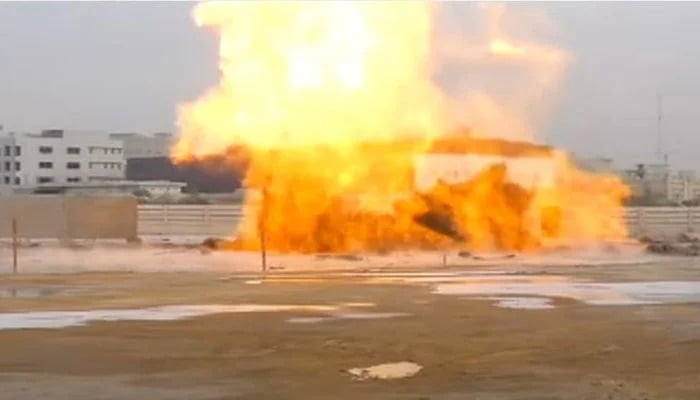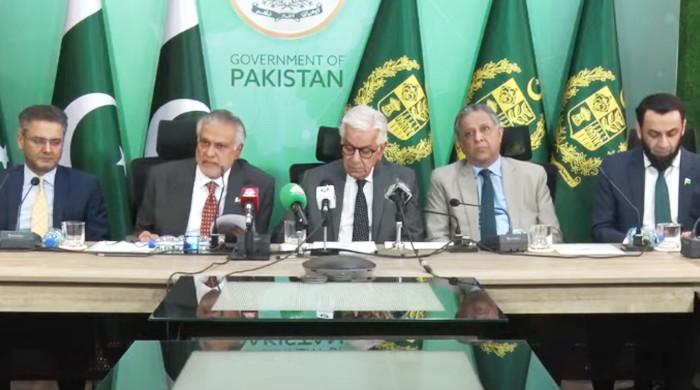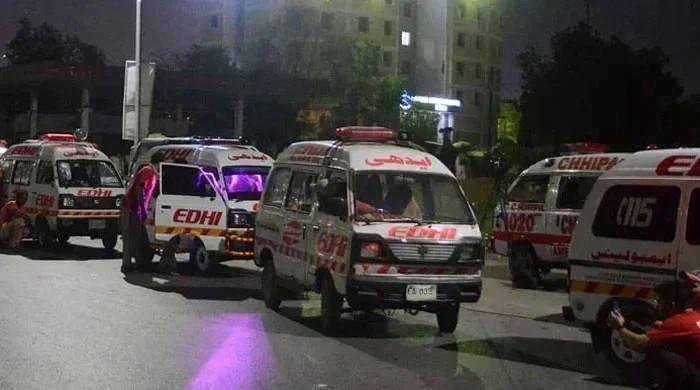Karachi blaze enters second day despite continuous firefighting efforts
Ex-fire officer advises against attempting to contain blaze, recommends alternative method to control it
March 30, 2025

- Methane leak blamed for uncontrollable underground fire.
- Fire may burn for up to ten days, says former PPL official.
- Former fire chief advises against extinguishing fire.
The fire that erupted during deep excavation in Karachi's Korangi Crossing area could not be brought under control, despite the blaze entering its second day on Sunday.
The fire broke out in the wee hours of Saturday when a local construction company was drilling beyond 1,100 feet deep for a tube well.
According to Chief Fire Officer Humayun Ahmed, methane gas is escaping from the ground under significant pressure. He explained that attempting to extinguish the fire at this stage could cause the gas to spread throughout the area, potentially endangering local residents.
Ahmed said that the fire can only be brought under control once the gas pressure subsides. He added that such fires can sometimes take two to three days to extinguish.
Meanwhile, a former managing director (MD) of Pakistan Petroleum Limited (PPL) said the fire was caused by biogenic gas and may take between a week to ten days to burn out completely.
While the nature of the gas remains unclear, the Sui Southern Gas Company had clarified that it has no installations near Korangi Crossing.
Chief Operating Officer of PPL Sikandar Memon said that the gas was not dangerous, although the size of the underground deposit was currently unknown. He confirmed that water samples were being collected, and further details were expected in the coming days.
Meanwhile, the former chief fire officer Kazim Ali Khan spoke to Geo News regarding the underground gas leak issue and advised that authorities avoid attempting to extinguish the fire immediately.
Instead, he recommended allowing the blaze to burn out naturally. "If the quantity of gas is limited, the fire will extinguish itself in 3 to 4 days," he said.
Khan noted that the mangroves in the area, along with sludge from nearby oil installations, could be contributing to the presence of biogas. He further explained that the released gas may contain dangerous components such as hydrogen sulfide or biogas. Hydrogen sulfide, he warned, is a highly toxic gas that can be fatal even in small amounts.
To contain the situation safely, the former fire officer suggested establishing earthen walls at a distance of 90 metres from the site of the.
Officials engaged in the firefighting operations admitted facing serious challenges in controlling the blaze.
Initially, firefighters attempted to douse the flames with water, but officials said this only intensified the heat. The strategy was later shifted to using soil and sand to smother the fire. More than 10 fire tenders, along with multiple water tankers, participated in the fire extinguishing operation.
However, it proved ineffective, as the high gas pressure kept causing the flames to resurface.











